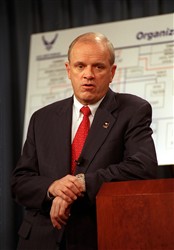|
WASHINGTON, Feb. 14, 2002 – U.S. special operations forces' use of satellite phones, global positioning systems and laser-designators to precisely locate targets in Afghanistan for long-range bombers isn't unusual in this day and age.

Army Secretary Thomas E. White at the Pentagon. DoD photo by R. D. Ward.
(Click photo for screen-resolution image);high-resolution image available. |
|
But, doing it on horseback is definitely out of the ordinary. This "great story," according to Army Secretary Thomas E. White, demonstrates the ongoing transformation of the U.S. military. "Whoever thought that 'transformation' would go back to horse cavalry," White remarked today. Yet, he said, the combination of high- and low-tech methods and equipment used in Afghanistan is an example of what transformation is all about. It involves changing how the Army thinks, leads, trains and fights. The Army is developing equipment, strategies and doctrine that require fewer personnel and lighter equipment that is more interoperable with the other services. These lighter, more-agile units will be able to deploy farther and faster. "We seek the same potent combination of new and proven technologies and advanced warfighting concepts, built upon tough resourceful soldiers that make things work," White told about 150 Congress members, key staff members and defense industry representatives. He spoke at a Capitol Hill breakfast co-sponsored by DFI International, a private research and analysis group, and the Army Caucus, a bi- partisan group that emphasizes the need for a strong Army. President George Bush selected White, a retired Army officer and a combat veteran, to lead the Army into the future. The 1967 West Point graduate was a brigadier general when he retired in 1990. He served two tours in Vietnam, commanded the 11th Armored Cavalry Regiment and served as executive assistant to the chairman of the Joint Chiefs of Staff. In his address, White said the Army must win the war on terrorism, transform to meet the challenges of the future, and secure the resources to do both. Those resources, he added, need to be invested in people, readiness and transformation. Winning the war on terror, he said, "is a non-negotiable contract with the American people." Army special operations forces did a magnificent job in Afghanistan, he noted, and now conventional light forces, the 101st Airborne and 10th Mountain divisions, are there as well. "You know the story," the secretary told the group. "Lousy terrain. Dead of winter. Seven thousand miles away in a place referred to as 'the graveyard of empires.' "From Egypt to Pakistan, from Kenya to Kazakhstan," he said, more than 14,000 soldiers are now deployed in support of Operation Enduring Freedom. Working with joint and coalition partners, they've defeated the Taliban, "significantly destructed Al Qaeda," liberated the people of Afghanistan, and installed an interim government. The Army is accelerating its transformation plans in the wake of last year's terrorist attack. "If transformation was an imperative before 9/11," he said, it is now "absolutely essential and fundamental." Operations in Afghanistan prove that requirements for Army forces continue to grow, White said. Currently, more than 179,000 soldiers and 38,000 Army civilians are deployed in 120 countries. Along with combating terrorism, they're securing detainees in Guantanamo Bay and ensuring regional stability in Central Asia. They're also conducting counter-terrorism training in the Philippines, deterring potential adversaries in Southwest Asia and maintaining peace in Bosnia, Kosovo, Macedonia, and the Sinai. "The point is, we're fighting this war and nobody's let us out of a single commitment that we already had on the tenth of September, and that is a challenge," he said. "Our soldiers are answering the call of duty, but we must ensure that the force remains appropriately manned for the force ahead." The Army has mobilized more than 24,000 Reserves and National Guardsmen for federal service at home and overseas. About 11,000 Army National Guard soldiers are employed on state-controlled missions -- guarding airports, seaports, reservoirs and critical infrastructure. More than 5,000 soldiers are deployed to safeguard the Winter Olympic Games. "There are more soldiers deployed on the ground in Utah, than there are in Afghanistan today," White noted. To meet the challenges of the 21st century, the Army is creating an "Objective Force" that is deployable, agile, versatile, lethal, survivable and sustainable. It will be able to deploy a brigade combat team anywhere in the world within 96 hours after lift off, have a division on the ground within 120 hours, and five divisions in theater within 30 days. Six brigade combat teams are already funded. The first two are training at Fort Lewis, Wash. White noted that 96 percent of the Army's $1.5 billion annual science and technology research and development budget is programmed to achieve Objective Force capabilities. In the meantime, White said, the Army is fielding an interim force to close the "capabilities gap" between today's heavy forces and the lighter forces of the future. "We're on schedule to fully equip the first interim brigade at Fort Lewis with the interim armored vehicle by February 2003," he said. "We intend to field five more of these interim brigades by 2007. One of them is funded in the fiscal 03 budget under consideration by Congress right now." The interim force will also allow time for leader development and experimentation, he said. "For the first time since I've been around," White said, "we will field something we can use as a bridge to get us from the legacy systems that we have today to the Objective Force on the other end. "We will field enough of these brigades so that we fill the near-term warfighting requirement of the commanders in chiefs, but we will also have enough of them so that we can conduct experimentation and try out and mix and match the components and subsystems that we expect to get out of the technology base."
|